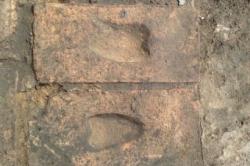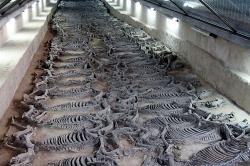INSTITUT SUPERIEUR D'ANTHROPOLOGIE
INSTITUTE OF ANTHROPOLOGY
ONLINE COURSES / COURS A DISTANCE
WINTER TERM : JANUARY 2016
REGISTER NOW
INDE –  Semri Kala - Archaeological relics dating back to more than 1,000 years have been found in a village on the outskirts of Bhopal, throwing open possibilities of finding an entire temple belonging to the 11th century Parmar era. The relics were discovered at Semri Kala village off the Kolar Road by a team of Bhopalwalk — a Twitter-based initiative to explore heritage of Bhopal— recently during one of their weekly heritage walks. At the village, beautifully carved parts of pillars, apex part of the temple and other remains were visible on the mound. Recently, two more Parmar era temple remains were found around Bhopal by the state directorate of archaeology, archives and museums. In Arwaria village on the Berasia road, interesting sculptures were discovered along with temple remains last month. A few days later, exquisite remains of an 11th century temple were found at Bhojnagar village off the Kolar road, about 15km from the city.
Semri Kala - Archaeological relics dating back to more than 1,000 years have been found in a village on the outskirts of Bhopal, throwing open possibilities of finding an entire temple belonging to the 11th century Parmar era. The relics were discovered at Semri Kala village off the Kolar Road by a team of Bhopalwalk — a Twitter-based initiative to explore heritage of Bhopal— recently during one of their weekly heritage walks. At the village, beautifully carved parts of pillars, apex part of the temple and other remains were visible on the mound. Recently, two more Parmar era temple remains were found around Bhopal by the state directorate of archaeology, archives and museums. In Arwaria village on the Berasia road, interesting sculptures were discovered along with temple remains last month. A few days later, exquisite remains of an 11th century temple were found at Bhojnagar village off the Kolar road, about 15km from the city.
http://www.hindustantimes.com/bhopal/1000-yr-old-temple-remains-found-on-outskirts-of-bhopal/story-WXOM9KedVzrIrYXpk9u5RP.html
ROYAUME UNI –  Flint - A major archaeological dig in Flint has uncovered further samples of the town’s medieval defences. The dig has also found evidence of the preservation of 18th Century stone frontage walls on Earl Street. A detailed report on all the archaeological findings made on the site, along with photographs, will go on public display at Flint Library and on the Flintshire County Council website at the end of the November.
Flint - A major archaeological dig in Flint has uncovered further samples of the town’s medieval defences. The dig has also found evidence of the preservation of 18th Century stone frontage walls on Earl Street. A detailed report on all the archaeological findings made on the site, along with photographs, will go on public display at Flint Library and on the Flintshire County Council website at the end of the November.
http://www.dailypost.co.uk/news/north-wales-news/flint-archaeological-dig-uncovers-further-10394255
AUSTRALIE –  Sydney - An archaeological dig at the site of the $2 billion Parramatta Square development in October uncovered the footings of a home built in 1810 and three other properties built from the 1870s. Archaeologist Mary Casey said the early house, built with locally made bricks and tiles, was home to emancipated convict John Holland and his wife Harriet. "[Holland] was captured for being a highway man in Derbyshire in England and he arrived out here in 1840," Dr Casey said. "He ran an inn... on Church Street." Dr Casey said Holland and his wife lived in their Macquarie Street home from 1860 to 1898. Several artefacts were also found at the dig, including perfume bottles, tiles, plates and cups.
Sydney - An archaeological dig at the site of the $2 billion Parramatta Square development in October uncovered the footings of a home built in 1810 and three other properties built from the 1870s. Archaeologist Mary Casey said the early house, built with locally made bricks and tiles, was home to emancipated convict John Holland and his wife Harriet. "[Holland] was captured for being a highway man in Derbyshire in England and he arrived out here in 1840," Dr Casey said. "He ran an inn... on Church Street." Dr Casey said Holland and his wife lived in their Macquarie Street home from 1860 to 1898. Several artefacts were also found at the dig, including perfume bottles, tiles, plates and cups.
http://www.abc.net.au/news/2015-11-06/house-of-ex-convict-john-holland-found-in-parramatta-centre-dig/6917460
CHINE -  Yatou - More than 500 horses entombed alive with a deceased emperor about 2,500 years ago will be restored and exhibited to the public next year, the Zibo city government in east China's Shandong Province said on Friday. The owner of the tomb, Qi Jinggong, was an emperor of the Qi State during the late Spring and Autumn Period (770 BC - 476 BC). Archaeologists said most of the horses were aged six to seven when they were buried in order to "accompany" the emperor underground, a common tradition for the time. The discovery provides valuable information with regard to the history, economy, military and burials of ancient China. The local government said it would invest more than 70 million yuan (11 mln U.S. dollars) to excavate and preserve the ancient horse pit over the next three to five years.
Yatou - More than 500 horses entombed alive with a deceased emperor about 2,500 years ago will be restored and exhibited to the public next year, the Zibo city government in east China's Shandong Province said on Friday. The owner of the tomb, Qi Jinggong, was an emperor of the Qi State during the late Spring and Autumn Period (770 BC - 476 BC). Archaeologists said most of the horses were aged six to seven when they were buried in order to "accompany" the emperor underground, a common tradition for the time. The discovery provides valuable information with regard to the history, economy, military and burials of ancient China. The local government said it would invest more than 70 million yuan (11 mln U.S. dollars) to excavate and preserve the ancient horse pit over the next three to five years.
http://news.xinhuanet.com/english/2015-11/06/c_134791514.htm?